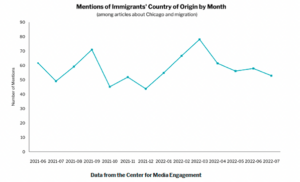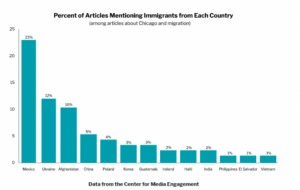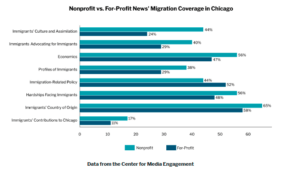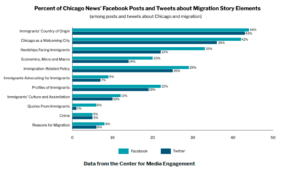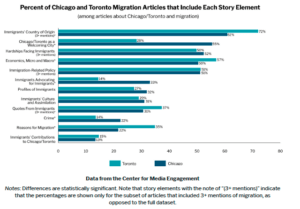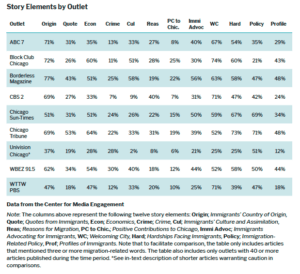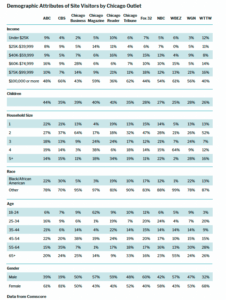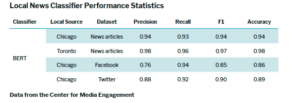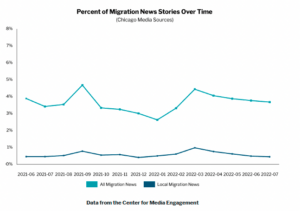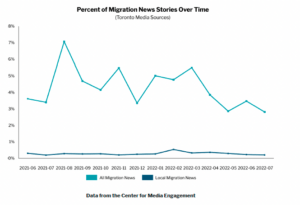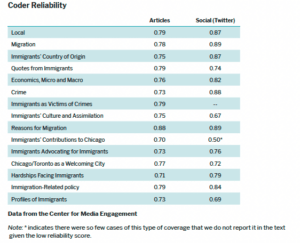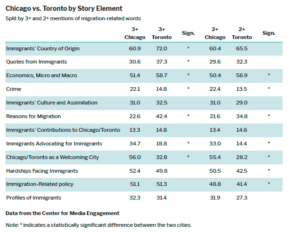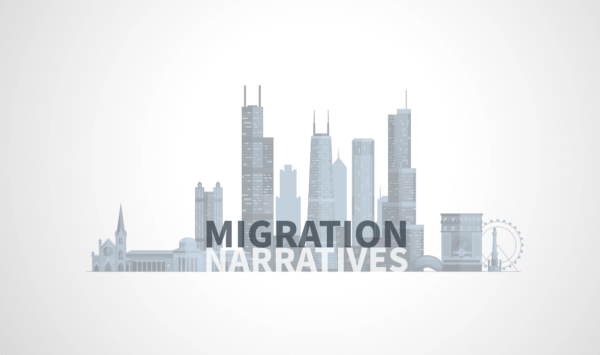
SUMMARY
Examining news media narratives about migration can reveal whether stories accurately reflect the experiences of immigrants. To better understand Chicago’s migration coverage, the Center for Media Engagement investigated how 23 local news outlets covered migration in their online articles and social media channels from June 2021 through July 2022. For comparison, we analyzed how eight news outlets in Toronto, Canada covered migration. Toronto was chosen as a comparison due to its reputation as an immigrant-friendly city.
Though there is no one right answer as to how the immigrant experience should be covered, the results of this analysis provide insight into important questions that should be asked about how the media approach migration stories.
KEY TAKEAWAYS
- Chicago’s migration coverage frequently mentioned immigrants’ countries of origin.
-
- Mexican immigrants were mentioned most often, corresponding with demographic numbers showing that Mexico is the top country of origin for immigrants living in Chicago.
- The next most frequently mentioned countries of origin were Ukraine and Afghanistan. This makes sense given the timing of our analysis, which overlapped with the Russian invasion of Ukraine and the Taliban’s takeover of Afghanistan.
- China and Poland, the fourth and fifth most frequently mentioned countries in coverage, are the second and third most common countries of origin for Chicago migrants.
- The Philippines and India, the remaining two countries in Chicago’s top five countries of origin, were mentioned less frequently in the coverage.
-
- Chicago coverage often described the city as welcoming to immigrants. Coverage also often mentioned hardships facing immigrants, economics, and immigration-related policy.
- Less frequently covered story elements included crime, reasons for migration, and immigrants’ positive contributions to Chicago.
- Social media posts by Chicago’s news media on Facebook and Twitter were more likely than articles to profile immigrants and to portray Chicago as a welcoming city. They were less likely to mention economics or to include quotes from immigrants.
-
- Facebook posts that quoted immigrants received fewer likes, shares, and comments. Profiles of immigrants received more likes and shares. Mentions of immigrants advocating for immigrants received more shares and comments.
- Replies and quote tweets, although infrequent in response to local tweets about migration, were six times more likely to be unfavorable toward immigrants and immigration than they were to be favorable.
-
- Overall, Chicago and Toronto media coverage was similar. There were several significant differences, however:
-
- Chicago migration coverage was more likely to portray the city as a welcoming place for immigrants, to describe immigrants advocating for immigrants, and to mention crime.
- Toronto migration coverage was more likely to include mentions of immigrants’ country of origin, economics, quotes from immigrants, and reasons for migration.
- Toronto’s news media shared reasons for migration more often than Chicago’s media.
-
- The most frequently discussed reason for migration in both cities was to escape political violence. The significant coverage of refugees fleeing Russia’s invasion of Ukraine and the Taliban’s takeover of Afghanistan likely contributed to this dominance.
- Toronto’s news media covered economic opportunities as a reason for migration more often than Chicago’s media. This finding mirrors an observation that Toronto’s news media more often discussed immigrants as entrepreneurs who were arriving in Canada to contribute to industries such as corporate business and technology, while Chicago’s coverage less frequently mentioned immigrants in this role.
-
-
CONSIDERATIONS FOR FUTURE COVERAGE
- Some migrant groups are covered less often than we might anticipate given their presence in Chicago. Are there groups that should be covered more or less?
- Should more frequently covered story elements, such as hardships facing immigrants and economics, receive the most attention? Should others be covered more?
- How could the prevalence of different story elements shape public understanding of immigrants and immigration issues?
- How should migration media narratives change, if at all?
- How does social media help or hurt the ability to convey migration narratives?
This analysis is important given that the public forms impressions of groups and issues through the stories told about them in the news media.1 Narratives can affect societal divisions and people’s political attitudes.2 However, it’s also possible for media coverage to improve attitudes toward different groups and issues.3 Counter-stereotypic, fact-based media narratives can reduce prejudice toward outgroups, for example.2 For better or for worse, the news media has the power to shape public impressions. Given this, how the media construct narratives about migration and what story elements they include in their coverage, could have important implications for attitudes toward immigrants and related public policies.
IMMIGRATION COVERAGE IN CHICAGO
The Center for Media Engagement analyzed local articles about migration from 23 Chicago news media outlets between June 2021 and July 2022. We identified news articles that mentioned both Chicago and international immigration and selected a subset for in-depth analysis.
Articles were sorted based on how many times they mentioned words related to migration; those that contained the highest number of mentions were analyzed. We did this so we focused our analysis on the most substantive coverage, as opposed to on articles that contained only a passing reference to migration. In total, we analyzed 1,000 articles from Chicago media. This equated to examining all articles that contained three or more migration mentions and a random subset of articles that contained two migration mentions.
We excluded articles that mentioned words related to migration, but were not about the migration of people from other countries to the U.S., such as articles about migration within the United States, the migration of animals, and people crossing the border for a purpose unrelated to migration (e.g., tourism). We also excluded articles that did not mention a person, place, or organization in Chicago (e.g., articles that mentioned Chicago only to advertise for a Chicago news station). This left 857 articles. For these articles, we recorded whether each article contained a series of story elements related to migration.
We then examined how these same news outlets covered Chicago migration on Facebook and on Twitter. Finally, we analyzed immigration-related media coverage in Toronto, a city known for its immigrant-friendly reputation, as a comparison.
We found that local Chicago news articles about migration covered many aspects of the immigrant experience. Of the story elements we examined, the most commonly covered was immigrants’ country of origin. Sixty percent of the articles mentioned countries from which people were immigrating. The next most common elements in the coverage were: Chicago as a welcoming city, hardships facing immigrants, economics, and immigration- related policy. In the pages that follow, we discuss each story element in more depth.
Which Migrant Groups are Covered?
Of the articles we analyzed, the most commonly mentioned story element in the coverage was immigrants’ country of origin (60% of articles). Examples include:
- “A fixture of this community is 5 Rabanitos owner Alfonso Sotelo, who left his home in Ixcapuzalco, a small town in Guerrero, Mexico, when he was 15 years old in 1991.” (Borderless Magazine)
- “Three months later, the Okseniuks are now living in Chicago’s Ukrainian Village neighborhood, thousands of miles from their war-torn home.” (Block Club Chicago)
- “Since the Afghan refugee crisis, the organization has opened up extra programs to assist the new community.” (NBC 5)
Looking month-to-month, coverage of immigrants’ country of origin was at its highest in September of 2021 (71% of articles) following the Taliban takeover of Afghanistan, and in March of 2022 (78% of articles) following Russia’s invasion of Ukraine. Mentions of countries from which people were migrating were at their lowest in October (45%) and December of 2021 (44%).
We analyzed which countries were most frequently mentioned in coverage. Mexico was referenced most often (23% of articles) followed by Ukraine (12%) and Afghanistan (10%). Frequent mentions of Mexico line up with the findings in reports such as New Americans in Chicago and A Global Welcome: Metro Chicago’s Approach to Immigrant Inclusion, which show that Mexico is the top country of origin for immigrants living in Chicago. According to the New Americans report, 45% of immigrants living in Chicago are from Mexico. Further, during the time period of our analysis (June 2021 to July 2022), the situations in Ukraine and Afghanistan were prominent local and national stories.4 After Mexico, the New Americans report identified the next most common countries of origin for Chicago immigrants as China (6% of immigrants), Poland (6%), the Philippines (4%), and India (4%). Each of these countries is mentioned in local Chicago migration coverage, as shown in the following chart. China and Poland were the fourth and fifth most commonly mentioned. Migrants from India and the Philippines were mentioned less frequently than migrants from Korea, Guatemala, Ireland, and Haiti.
Of the articles that mentioned an immigrant’s country of origin, about 30% mentioned more than one immigrant group. Qualitatively, there wasn’t a noteworthy difference in the tone of the articles talking about a single group and those talking about multiple groups.
How is Migration Covered?
The next most common story element in Chicago migration coverage was depictions of Chicago as a welcoming city. This element appeared in 55% of the articles. Articles describing Chicago as welcoming would, for example, describe the useful resources provided to immigrants, feature local politicians expressing support for immigrants, and cover cultural celebrations.
- “The Cook County Public Defender’s Office began representing non-citizens regardless of immigration status in court two months ago, and has already seen successes among the dozen cases the office has dealt with.” (Block Club Chicago)
- “In the two years she’s lived in Rogers Park, Moorthy says neighbors have become friends, and she’s built a community. That’s despite the coronavirus pandemic and shutdowns. She regularly walks along Lake Michigan and picks up produce from local markets that remind her of her native India. ‘I definitely feel very much at home in Chicago,’ says Moorthy, 40. ‘It’s my chosen home in the U.S., and Rogers Park has been really healing and home-like for me.’” (Chicago Sun-Times)
- “Chicago organizations, schools and families are preparing to welcome more refugees from Ukraine. Just this week, St. Nicholas Cathedral School in the city’s Ukrainian Village neighborhood has received three new Ukrainian students, all fleeing the war with Russia with their families. The school now has 16 Ukrainian students in total. People have been generous, and donations are arriving daily.” (ABC 7)
Mentions of Chicago as a welcoming city were highest during the Taliban takeover of Afghanistan (August and September of 2021) and during Russia’s invasion of Ukraine (March of 2022).
The next three most commonly featured aspects of migration in Chicago coverage appeared in around half of the articles we examined.
- Hardships facing immigrants, or difficulties specific to the immigrant experience, such as encountering xenophobia, experiencing trauma from fleeing war-zones, and feeling divided between two cultures, were mentioned in just over half of the Chicago articles featuring migration (51%).
- “Each time a police siren wailed or an airplane whirred overhead, Olena Raczkiewycz would relive the terror of her last few days in Ukraine, when Russian tanks and bombs besieged her country. This sensation lasted for the first month or so after her late February escape from Kyiv. The everyday innocuous sounds that might mimic an air raid alert or rockets launching could plunge her into a state of turmoil. Although she’s now in Chicago and safe, the trauma of fleeing her home amid war still lingers.” (Chicago Tribune)
- Economics was mentioned in half of the Chicago articles featuring migration. These articles discussed topics such as taxes, wealth inequality, or gentrification.
- “Workers are striking over low wages and an increase in health insurance premiums…” (Crain’s Chicago Business)
- “With hope, Amer applied for an SIV [Special Immigrant Visa]. The process took years, concluding with him arriving in Chicago in February 2015. The first year was difficult — immigrants are not eligible for all work immediately, and after working as a translator, project manager and owning his own construction company, he felt sure he would qualify for more challenging jobs. RefugeeOne helped him get settled. He worked as a server at a Mediterranean restaurant, taking two buses to shifts and building enough money to support his family.” (Chicago Tribune)
- Immigration-related policy, such as immigration reform, refugee resettlement plans, and deportation policies, was mentioned in 49% of the articles.
- “The General Assembly passed the bill, known as the Illinois Way Forward Act, in May, and it calls for local officials to end existing contracts to detain those in immigration custody by Jan. 1.” (Chicago Sun-Times)
- Discussions of immigration-related policies were most prevalent in August of 2021 (63%), when Gov. JB Pritzker signed several bills related to immigration, most prominently the Illinois Way Forward Act, and in February of 2022 (63%) when immigration detention centers closed in Illinois.
The next four story elements were each included in around a third of the local Chicago migration articles. Two of the four showed some variation over time, as described below.
- Immigrants advocating for immigrants (33% of the articles) included mentions of organizations representing the rights of immigrants and immigrants volunteering to support refugees.
- Profiles of immigrants (32% of articles) shared the day-to-day experience of an immigrant or a detailed description of an immigrant’s life.
- Immigrants’ culture and assimilation (31% of articles) included details about the food, music, or art from an immigrant’s home country or their new culturalexperience in Chicago. This type of coverage was at its highest in November of 2021 (46%), when several articles discussed immigrants and Thanksgiving by, for example, describing immigrants volunteering to give those in need food from their culture.
- Quotes from immigrants (30% of articles) appeared most commonly in articles written in July of 2021 (43%) and in December of 2021 (44%).
The next three story elements were referenced in less than a quarter of the articles we analyzed.
- Reasons for migration (22% of articles) included better economic opportunities or escaping violence in their home country.
- The most common motivation for migration was to escape political violence in one’s home country for reasons such as war, persecution, or governmental instability (77%). The second most common reason was to seek out economic opportunities (10%).
- Reasons for migration were included most frequently in August of 2021 (32%), coinciding with the Taliban’s takeover of Afghanistan, and in March and April of 2022 (39% and 35%, respectively), coinciding with Russia’s invasion of Ukraine.
- Crime (22% of articles) included mentions of, for example, gun violence, hate crimes, and neighborhood safety, regardless of whether an immigrant was involved. We examined whether articles mentioned immigrants committing a crime, but it occurred so infrequently that we weren’t able to detect it reliably. Eight percent of articles mentioned an immigrant being a victim of a crime. Mentions of crime were most prevalent in July of 2022 (47%), coinciding with the Highland Park parade mass shooting on July 4th when several immigrant and Latinx families were deeply affected.
- Immigrants’ positive contributions to Chicago included portrayals of immigrants bringing economic, cultural, or community-building benefits to the city and was the least common story element in the articles we evaluated. This was included in 13% of the articles, a rate that did not vary much over time.
We examined one additional story element that is not depicted in the chart because it occurred so infrequently that we weren’t able to assess whether we were reliably detecting it: criticism of immigrants. We defined this story element as depictions of individuals being critical of immigrants, including portraying immigrants as public nuisances, economic burdens, or cultural outsiders. One possible example of this was: “Clay County Council President Larry Moss seemed to sum up the prevailing view among the county’s elected leaders when he said most of the immigrants at the jail are people ‘you wouldn’t want in your neighborhoods.’” (Injustice Watch)
We also looked at how often specific terms and concepts were mentioned in the coverage. Children (including the terms kid, child, daughter, son, and baby) were mentioned most often, appearing in nearly half of the articles (49%). Refugees (including the terms refuge and asylum) were mentioned in four in ten (40%) of the articles we analyzed. Twenty-seven percent of articles used words related to undocumented immigration (including the terms immigration status, unauthorized, without legal, without authorization, and country illegally). Eighteen percent mentioned students and study permits. The other words and phrases we examined appeared notably less frequently, with 8% of articles mentioning DACA (including the terms dreamers, deferred action, and childhood arrivals), and 2% mentioning essential workers, unaccompanied (as in unaccompanied children), and migrant workers.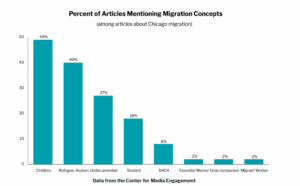 We can compare these numbers to the demographic makeup of Chicago. For example, 31% of Chicago residents are at risk of deportation and 27% of local migration articles mention undocumented immigrants, a comparable rate. Yet given that we look only at the subset of local articles focused on migration, perhaps more coverage is required. Demographic information about Chicago’s immigrants:5
We can compare these numbers to the demographic makeup of Chicago. For example, 31% of Chicago residents are at risk of deportation and 27% of local migration articles mention undocumented immigrants, a comparable rate. Yet given that we look only at the subset of local articles focused on migration, perhaps more coverage is required. Demographic information about Chicago’s immigrants:5
- 1 in 3 children in Chicago have at least one immigrant parent.
- The largest refugee resettlement agency in Chicago serves 2,500 people every year; 2,500 Afghans resettled in Illinois between August 2021 and August 2022.
- 842,000 Chicago residents are at risk of deportation (31%).
- 189,000 Chicago immigrants are students enrolled in pre-K through college (7%).
- There are 29,000 to 34,000 DACA recipients in Illinois (1% if all in Chicago).
- Immigrants make up 21% of Chicago’s labor force.
- 30,000 to 50,000 migrant farmworkers work in Illinois every summer.
Questions to Consider
When evaluating these results, it is important to keep in mind that there is no one right answer as to how the immigrant experience should be covered. When looking at how often various story elements are covered, however, the following questions can be considered:
- Some migrant groups are covered less often than we might anticipate. Which groups should be covered more or less?
- Migrants from the Philippines and India, for example, are covered less often than we would expect based on their population size. What, if anything, should be done to increase coverage of these groups?
- Should the story elements covered most often — the countries from which people are immigrating, Chicago as a welcoming city, the hardships facing immigrants, economics, and immigration-related policy — be those receiving the most attention?
- Should story elements covered less frequently — reasons for migration and immigrants’ positive contributions to the city — be covered more?
- How could the prevalence of different story elements shape public understanding of immigrants and immigration issues?
These considerations, we hope, will stimulate conversations within newsrooms and the broader immigration ecosystem in Chicago.
IMMIGRATION COVERAGE FROM FOR-PROFIT V. NONPROFIT NEWSROOMS
We also examined whether there were differences in the kinds of story elements included in the coverage of for-profit newsrooms versus nonprofit newsrooms in Chicago. The for-profit newsrooms were ABC 7, CBS 2, the Chicago Defender, Chicago Magazine, Chicago Sun-Times, Chicago Tribune, Crain’s Chicago Business, Fox 32, NBC 5, Telemundo Chicago, The Chicago Reader, Univision Chicago, WGN, and the Windy City Times. The nonprofit newsrooms were Block Club Chicago, Borderless Magazine, City Bureau, Injustice Watch, South Side Weekly, The Chicago Reporter, WBEZ 91.5, and WTTW PBS.6
In general, nonprofit newsrooms covered more migration-related story elements in their reporting than for-profit newsrooms. The biggest difference between the types of newsrooms was how often they mentioned immigrants’ culture and assimilation in their coverage: This story element appeared in 44% of articles from nonprofit newsrooms and in 24% of articles from for-profit newsrooms. Similarly, nonprofit newsrooms were more likely than for-profit newsrooms to describe other aspects of immigrants’ personal experiences, such as including profiles of immigrants, hardships facing immigrants, and immigrants’ country of origin. They were also more likely to document their activities in Chicago, like sharing stories about immigrants advocating for immigrants and immigrants’ positive contributions to Chicago, as well as to mention economics. For-profit newsrooms only covered one story element more often than nonprofit newsrooms: immigration-related policy. There were no differences between the types of newsrooms in how often they included quotes from immigrants in their articles, discussed reasons for migration, mentioned crime, or portrayed Chicago as a welcoming city.
The differences between nonprofit and for-profit newsrooms were largely driven by reporting from Borderless Magazine, a nonprofit news organization with a specific focus on immigration. When we exclude Borderless Magazine’s coverage from the analysis, only three differences remain: nonprofit newsrooms are still more likely to mention culture and economics in their immigration coverage than for-profit newsrooms and for-profits are still more likely to report on immigration-related policy. Without the influence of Borderless Magazine, there were no other differences between the coverage from nonprofit and for-profit news organizations.
IMMIGRATION COVERAGE IN SOCIAL MEDIA VS. ARTICLES
We also analyzed Facebook and Twitter posts made by the same Chicago media outlets during the same time period7 and examined whether the portrayal of migration varied. We identified 720 Facebook posts and 633 tweets about Chicago and migration.
The story elements we examined were less frequently mentioned on Facebook and on Twitter than they were in the media articles we analyzed. For example, while 60% of Chicago articles featuring migration mentioned immigrants’ country of origin, only 44% of Facebook posts and 43% of tweets did the same. This is likely a function of the limited length of Facebook posts and tweets. Overall, elements also tended to be mentioned more frequently on Facebook than on Twitter. For example, 33% of Facebook posts mentioned the hardships facing immigrants compared to 22% of tweets. This also may be a function of length, as Facebook posts were, on average, longer than tweets.8
We looked at whether the percentage of Facebook posts and tweets was higher or lower than expected based on the percentage of articles about each story element, taking into account that all elements appeared less frequently on social media.9
Local migration coverage of each story element, based on the relative percentages, was similar on social media and in news articles. The instances in which there were differences tended to be small, but worth noting.
- Three story elements appeared relatively less frequently on social media than in articles:
- Economics, which had the largest difference between coverage in articles and on social media that we observed, was mentioned in 20% of Facebook posts and 14% of tweets. Based on article coverage, we would have anticipated 31% of Facebook posts and 26% of tweets would discuss economics.
- Quotes from immigrants were included 6% less often than anticipated on Facebook and 8% less often on Twitter based on article coverage.
- Immigrants advocating for immigrants were featured 6% less often on Facebook than anticipated based on article coverage.
- Two story elements appeared relatively more frequently on social media than in the articles:
- Profiles of immigrants were 8% more common on social media than anticipated based on article coverage.
- Descriptions of Chicago as a welcoming city were 6% more common on social media than anticipated based on article coverage.
Social Media Engagement
For Facebook, we looked at what types of posts, based on the story elements above, correlated with likes, shares, and comments.10
- Likes: Quotes, economics, crime, hardships, and immigration-related policy received fewer likes on Facebook posts about Chicago and migration. Profiles of immigrants received more likes.
- Shares: Quotes, crime, and immigration-related policy received fewer shares of Facebook posts about Chicago and migration. Posts that mentioned immigrants advocating for immigrants and profiles of immigrants were shared more often.
- Comments: Quotes and mentions of culture/assimilation received fewer comments on Facebook posts about Chicago and migration. Posts that mentioned immigrants advocating for immigrants received more comments.
We also looked at the replies and quote tweets in response to the news organizations’ posts about Chicago and immigration. A brief review made clear that these tweets were not substantive and did not include the story elements we analyzed in the Chicago media’s social posts. Instead, the most common story element was the sentiment expressed about immigrants and the news media. We examined what sentiment the tweets expressed and found that of the 189 retweets and replies to Chicago news organizations’ tweets about migration, 7% were favorable toward immigrants and immigration, 42% were unfavorable toward immigrants and immigration, and 7% were unfavorable toward the media.11
Questions to Consider
When evaluating these results, it is important to keep in mind that there is no one right answer as to how the immigrant experience should be covered. When looking at how often various story elements are covered, the following questions can be considered:
- Where in the ecosystem should immigration coverage happen? The news media? Social media? Somewhere else, like theater performances or entertainment programming?
- Coverage goals must be attentive to the medium — how do social media platforms, like Facebook and Twitter, lend themselves to immigration coverage?
- Quotes from immigrants may not yield engagement. What are other ways to increase engagement with immigration-related coverage on social media?
- How does social media help or hurt the ability to convey migration narratives?
These considerations, we hope, will stimulate conversations within newsrooms and the broader immigration ecosystem in Chicago.
COMPARING CITIES: IMMIGRATION COVERAGE IN CHICAGO VS. TORONTO
We next compared immigration coverage by the 23 news sources in Chicago to eight news sources in Toronto. Toronto was selected for comparison given its identity as an immigrant-friendly city. We identified 500 articles that most frequently mentioned migration and Toronto. After reviewing them to make sure that they were substantively about migration and Toronto, we were left with 362 articles.
It’s important to note one difference when comparing the two cities. When we chose the articles for in-depth analysis, we selected articles that contained the most mentions of migration. In Chicago, 93% of the 1,000 articles mentioned migration 3+ times. In Toronto, only 68% of the 500 articles mentioned migration 3+ times. For this reason, we analyzed (a) all articles we coded, regardless of how often migration was mentioned and (b) the subset of articles where migration was mentioned 3+ times. When there were differences between (a) and (b), we leaned on (b) since it is more comparable across the cities. In the charts below, we present the results of the 3+ mentions (b) for: country of origin, quotes from immigrants, hardships facing immigrants, and immigration-related policy as the results differ across (a) and (b).12
Overall, coverage of immigration in Chicago and Toronto had much in common. Of the 12 story elements we present in the chart below, five were statistically indistinguishable across the two cities: immigrants’ positive contributions to the city, immigrants’ culture and assimilation, profiles of immigrants, immigration-related policy, and hardships facing immigrants.
Of those cases where differences in coverage were detected, three story elements differed between the cities by less than 10%: crime, quotes from immigrants, and economics. The remaining four story elements had larger differences. Immigrants’ country of origin was mentioned 11% more often and reasons for migration was mentioned 13% more often in the Toronto media compared to the Chicago media. Immigrants advocating for immigrants appeared 19% more often in Chicago than in Toronto. The largest difference between coverage of story elements that we detected was 27%, with 55% of Chicago articles describing Chicago as a welcoming city and only 28% of Toronto articles describing Toronto as a welcoming city. We discuss the cases where the coverage differed in more detail below.
Story Elements Mentioned More Often in Chicago than in Toronto
Three story elements were covered more in Chicago media than in Toronto media: portraying the city as welcoming, immigrants advocating for immigrants, and crime.
A greater proportion of Chicago’s news articles portrayed the city as welcoming (55%) than in Toronto (28%).13 Based on a qualitative examination of the news articles, these differences could be present for a few reasons. Attitudes toward migration and the value of multiculturalism may be more aligned in Canada and Toronto than in the U.S. and Chicago. Chicago’s news articles tended to position the city as a force in opposition to a national climate that was less welcoming to immigrants. Chicago was depicted as an exception or pioneer in the U.S. in terms of offering services to immigrants, as exemplified in an article from Block Club Chicago which stated:
Cook County is the third jurisdiction, after San Francisco and Alameda County, California, to offer representation to immigrants facing deportation. The law moves Cook County closer to creating a more “welcoming place for everyone to call home,” Preckwinkle said. Public Defender Sharone Mitchell said the law allowed the office to respond to the needs and concerns of Chicago’s immigrant communities.
In contrast, Toronto’s news articles talked about welcoming immigrants as a part of Canada’s national identity, so it seemed taken for granted that their city would respect and support immigrants. This more nationalized narrative toward “New Canadians” perhaps resulted in the lack of explicit statements about Toronto’s welcoming policies. However, the idea of a successful multicultural Canadian identity was not without critics. Although it was not the dominant narrative, a few articles mentioned people pushing back on this portrayal of Canadian society, such as in this article from New Canadian Media:
A fourth-year University of Toronto student and political science major, Eid shared her story along with other immigrant and Indigenous youth at a workshop during the recent fourth annual Metropolis conference on the benefits and drawbacks of multiculturalism policy in Canada. “In theory, to me, multiculturalism is ideal and holds great potential for Canadian society,” says Eid. “However, when I see it in practice, multiculturalism is merely a tool that the Canadian government uses to mask the history of colonization, slavery and the ongoing systemic racism in all avenues in society.”
Another possible reason that more Chicago news articles mentioned a welcoming policy or event is that stable, pre-existing resources or benefits for immigrants are arguably less newsworthy than policy change. During the period of the study, Chicago implemented several new policies to expand immigrants’ rights, particularly for people who are undocumented, such as providing public defenders for deportation cases, ending immigrant detention centers in nearby counties, and extending Medicare coverage to undocumented seniors. These issues received significant coverage in Chicago media. The focus on local efforts to broaden immigrants’ rights was also reflected in the fact that Chicago articles were also more likely to include stories of local immigrants advocating for immigrants (33%) than Toronto articles (14%). This difference could also be driven by the fact that Chicago has a rich and active non-profit infrastructure that supports migrants and refugees.
News outlets from both cities published articles that mentioned crime, however Chicago articles mentioned it significantly more often (22%) than Toronto articles (14%).14 One reason for this could be that concerns about public safety are more salient in Chicago’s discourse, as we included any mentions of local crime regardless of whether an immigrant was involved. Eight percent of articles from each city mentioned an immigrant who was a victim of crime.
Story Elements Mentioned More Often in Toronto than in Chicago
Four story elements were mentioned more often in Toronto news articles than in Chicago news articles: immigrants’ country of origin, economics, quotes from immigrants, and reasons for migration.
Toronto news articles mentioned immigrants’ country of origin more often (72%) than Chicago (61%). When a country of origin was mentioned, the most common group in Chicago’s coverage was Mexican immigrants (23%). Ukrainian (13%) and Afghan (12%) immigrants were the most common groups mentioned in Toronto’s coverage followed by Indian (10%), Chinese (9%), Syrian (6%), Mexican (6%), and Filipino (4%) immigrants. The most common home countries of Toronto immigrants include the Philippines (10%), China (10%), and India (8%).
More news articles from Toronto outlets (57%) referenced economics than from Chicago outlets (50%).15 The Toronto news media and politicians were often matter-of-fact about Canada’s need for migrants to sustain the economy. As one National Post article reported:
Ontario’s immigration agreement with the federal government expires in the fall and the province is pushing for a higher number of skilled workers and more flexibility on the types of workers it can attract. Monte McNaughton, the provincial minister of labour, immigration, training and skills development, said in an interview that hundreds of thousands of jobs are going unfilled in Ontario and it is costing the economy a lot of money. “That’s why we’re setting out to renegotiate the Ontario- Canada immigration agreement that expires this fall, to give Ontario more of a say in the number of immigrants and the kind of immigrants that we want to build a stronger economy,” he said in an interview.
This pragmatic tone was similar when Toronto articles discussed another common economic story element: how influxes of migrants affected housing prices in Toronto. Although Chicago’s news media did mention economics, fewer were as direct about the ties between immigration and the economy.
Quotes from immigrants were included more often in Toronto coverage (37%) than they were in Chicago coverage (31%). Immigrants’ quotes in both cities’ media commonly featured refugees sharing stories about their journey and hardships, immigrants speaking up for their rights, and discussions of immigrants’ culture.
Toronto’s news media shared immigrants reasons for migration (35%) more often than did Chicago’s (22%).16 In Chicago and Toronto, the most frequently discussed reason for migration was to escape political violence in one’s home country (77% of articles giving a reason in Chicago, 67% in Toronto). The significant coverage of refugees fleeing Russia’s invasion of Ukraine and the Taliban’s takeover of Afghanistan likely contributed to this dominance.
There were also important differences in which reasons for migration were included. Toronto’s news media covered economic migration more than Chicago’s; out of the articles that cited immigrants’ reasons for migration, a quarter from Toronto mentioned economic opportunities (25%) compared to 10% from Chicago.17 This finding mirrors a qualitative observation that Toronto’s news media more often discussed immigrants as entrepreneurs who were arriving in Canada to contribute to industries such as corporate business and technology, while Chicago’s coverage less frequently mentioned immigrants in this role. When coverage in Chicago did mention immigrant business owners, it was often restaurant owners to highlight the cultural and culinary diversity of a neighborhood.
Other reasons for migration, such as domestic violence and climate change or natural disasters, were rarely mentioned in either local news ecosystem.
Immigration-Related Words Used in the Media
We next looked at immigration-related words used in the coverage. There are some differences in the words used by each city, with Toronto more likely to mention refugees and students and Chicago more likely to mention undocumented immigrants and DACA.
Questions to Consider
When evaluating these results, it is important to keep in mind that there is no one right answer as to how the immigrant experience should be covered. When looking at how often various story elements are covered, however, the following questions can be considered:
- How should migration narratives change, if at all?
- Toronto coverage shows it is possible to include more quotes and reasons for migration, although both cities could cover these more. How do you think Chicago and Toronto could learn from each other?
- How would you expect these findings to shift during different time periods?
These considerations, we hope, will stimulate conversations within newsrooms and the broader immigration ecosystem in Chicago.
STORY ELEMENTS BY OUTLET
We also examined local migration coverage by outlet. As shown in the chart below, the Chicago Tribune and Chicago Sun-Times had the highest number of articles mentioning Chicago and local migration. This was followed by Borderless Magazine and Univision Chicago. 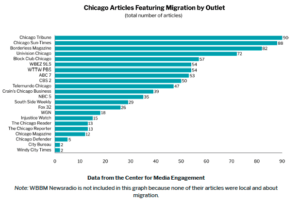
We next looked at what story elements were covered by each outlet. For example, 71% of ABC 7 articles mentioning Chicago frequently mentioned international immigration and included immigrants’ country of origin. We only included outlets for which we analyzed over 40 immigration-related articles during the period of the study.
The outlet with the most coverage including immigrants’ country of origin, immigrants’ culture and assimilation, and immigrants advocating for immigrants was Borderless Magazine. The Chicago Tribune led in mentioning quotes from immigrants, economics, hardships facing immigrants, and immigration-related policy. The Chicago Tribune and Borderless Magazine were equally likely to provide profiles of immigrants. Block Club’s coverage had the most mentions of immigrants’ positive contributions to Chicago and of Chicago as a welcoming city. WBEZ led in mentions of crime and CBS led in sharing immigrants’ reasons for migration.
We make special note that although we did analyze more than 40 migration-related local articles published on the Univision Chicago website, they tended to be much shorter than the article text from other outlets. As shorter articles, by nature, typically contain fewer story elements, we urge caution in drawing any conclusions about Univision Chicago’s coverage relative to the others.
NEXT STEPS
There are several directions that future work can take to further our understanding of the state of immigration coverage in Chicago and beyond:
- How do different portrayals of immigration affect what people think? And, importantly, how does this vary across different audiences?
- Who is authoring articles about local migration and what is the relationship between the authors, their expertise on immigration-related policy, and the type of coverage they produce?
- What initiatives increase the amount of coverage of local migrants?
- What do immigrants think about the coverage and how would they like to see themselves portrayed in the media?
- How do the findings vary over time?
METHODOLOGY
To analyze the coverage, we examined articles published on 23 local Chicago news websites from June 2021 through July 2022.
Chicago-Based News Organizations
For comparison, we examined articles published on eight local Toronto news websites during the same time period.
Toronto-Based News Organizations
| Outlet name | Website URL |
| CBC Toronto | https://www.cbc.ca/news/canada/toronto |
| CP24 | https://www.cp24.com/ |
| Hamilton Spectator | https://www.thespec.com/ |
| New Canadian Media | https://newcanadianmedia.ca/ |
| The Globe and Mail | https://www.theglobeandmail.com/ |
| The National Post | https://nationalpost.com/ |
| The Record | https://www.therecord.com/ |
| Toronto Star | https://www.thestar.com/ |
For context, we collected available demographic information about the web audience for sites that were available via Comscore in June of 2022. The results are included below:
To collect articles from the 31 sites, we collaborated with ScrapeHero (SH), a web scraping organization. SH collected articles from all websites between June 1, 2021 and July 31, 2022. To ensure the most accurate dataset possible, we conducted a series of scrape tests between May 31, 2022 and July 26, 2022. We chose a date and manually coded the website on the same day that SH ran their scraping tool. For each outlet, we computed the percentage of cases that both the Center for Media Engagement (CME) and SH identified. We then averaged the percent matching across the 31 media outlets. On average, the CME manual coding matched the SH automated scraper 87% of the time. For nearly all of the scrape tests, SH identified more articles than the CME team. On average, CME identified only 3% of articles per outlet that SH did not obtain with its scraper. This was an acceptable rate of overlap and we therefore proceeded with the scraping.
In total, SH captured 373,563 articles from Chicago and 220,206 articles from Toronto. Although we attempted to capture all articles posted to the news website within the timeframe, the number of articles gathered over time on some sites suggests that we were not able to pull the full archive of articles for all sites.18
We used Google Translate to translate news stories from Spanish into English. An undergraduate research assistant who is a native Spanish speaker reviewed a series of Google News article translations from Spanish to English and determined that although there were grammatical errors, the main points of the articles were discernible. We applied Google Translate to Spanish articles appearing in the Chicago Sun-Times, the Chicago Tribune, Univision Chicago, and Telemundo Chicago.
To identify stories about migration or immigration efficiently, we pulled 1,200 news stories assisted by a machine learning classifier that detects whether or not the stories are about migration or immigration. Those news stories were manually reviewed by two coders and individually coded (Krippendorf’s alpha = 0.96). Using the BERT machine learning model (i.e., a machine learning technique for natural language processing pre-training developed by Google), we trained a classifier to detect migration/immigration stories with the human labels. We calculated the performance of the language classifier, which was adequate as shown in the table below. Next, we generated predictions of migration stories for the entire dataset (n = 593,769).
We tested the performance of the same classifier with a random subset (n = 100) for Twitter (collected via the Academic API) and Facebook (collected via CrowdTangle) data with human labels for validation. The performance metrics are shown below.
We pulled 1,200 stories that were either potentially local news or not based on a machine learning classifier from both Chicago and Toronto media sources to detect local content by human reviews. Two coders reviewed a subset of the articles to see if a news article mentioned anything that is local to Chicago (or Toronto) such as a place, a person, a landmark, or the city itself (Krippendorff’s alpha = 0.80). After, the rest of the articles were individually coded. With those human labels, we trained the BERT language model. The BERT model showed strong performance overall as shown in the table below.
Again, we tested the performance of the local BERT classifiers for the Facebook and Twitter data that were collected from the same news sources by using a 200 subset from each Facebook and Twitter. The performance is shown in the table below.
In Chicago, between 2.6% and 4.7% of monthly articles were identified as referencing migration. These included anything from articles that used the word “immigration” to articles substantively focused on migration. This amounts to between 630 and 1,240 articles posted by the 23 Chicago news outlets we analyzed. Of these, between 11.7% and 22.1% were classified as local. This is between 95 and 269 articles a month about local migration story elements.
In Toronto, the percentage of monthly articles identified by our classifier as being about migration varied between 2.8% and 7.1%, or between 449 and 974 across the eight outlets we analyzed. Per month, between 3.9% and 11.4% of the migration articles were classified as local, which amounts to between 29 and 89 articles.
There was limited variation month-to-month in local migration articles. In Chicago, the largest number of local migration articles were posted in March of 2022 and in Toronto, February of 2022.
Migration and Local Migration Coverage
We took the subset of articles identified as being both local and about migration and we sorted them based on how much migration content the classifier predicted that they would contain. We took the 1,000 articles from Chicago identified by the classifier as containing the highest levels of migration content and the 500 articles from Toronto identified by the classifier as containing the highest levels of migration content. We did this instead of a random sampling strategy because random sampling could yield articles with only a single reference to migration as opposed to articles that went in-depth.
We developed a codebook outlining what content we wanted to examine in each of the articles. We then had a team independently code a minimum of 10% of the articles (100 articles in Chicago and 50 articles in Toronto). We did this so that we could assess whether our coding instructions were clear enough that people would reach similar conclusions when evaluating the content of an article.
Krippendorff’s alpha was calculated to measure the agreement between coders. The reliability coefficient was acceptable for both local and migration evaluations, as well as all twelve story elements. The remaining 90% of the dataset was then coded. 1,219 articles were determined by the coders to both be local news and mention something about migration; only these articles were coded for the remaining story elements. The researchers attempted to code for other story elements, such as whether a part of the article was critical of immigrants or whether the article mentioned crime committed by immigrants, but the elements appeared so infrequently that we were unable to determine whether we detected them reliably. More detail about the other coding categories can be found in the table below.
We adapted the codebook for social media and obtained reliability on the Twitter data, coding 250-350 Tweets independently and comparing the results.
Replies and quote tweets were analyzed separately. We pulled the related replies and quote tweets using conversation ID (where an original tweet creates threads of conversation that include replies such as responses to the tweet and responses to the reply) of those original tweets about local and migration stories from the Chicago Twitter accounts through the twarc2 Python library. Here, the Krippendorff’s alpha for 169 sample tweets was 0.71 for tweets favorable toward immigrants and immigration, 0.73 for tweets unfavorable toward immigrants and immigration, and 0.81 for tweets that were negative about the news.
We conducted the analyses to compare the coverage in Chicago and Toronto in two ways. First, we ran the analyses using all 1,219 articles that were determined to (1) mention Chicago/Toronto and (2) mention international migration during the coding process. We ran the same analyses again, yet only included articles that were (1) local and (2) migration-related AND (3) that the classifier indicated contained at least three migration-related words (1,075 articles). We did this because we had all available articles published on the sites that contained three or more migration-related words. We only have a subset of articles that mentioned two migration-related words. By looking at both datasets, we ensure that we’re not drawing conclusions that only hold because one site or one city has more articles with only two migration-related words. The results remain largely the same in terms of the direction of the results across the two methods (see table below). In the cases where the direction changed, we reported the percentages from the articles that contained at least three mentions in the body of the report.
ACKNOWLEDGEMENTS
With thanks to Meg Turner and Mary Margaret Burniston, Eunbee Chu, Delaney Glosser, Arlinne Montemayor Hernandez for their assistance with coding the articles. Thanks to Arlinne Montemayor Hernandez for reviewing the translations. Thanks to Gina Masullo and Christian Overgaard for their help early in the project. Thanks to Ashley Muddiman for her assistance in coding the replies to tweets. Support for this study was provided by the Walder Foundation.
SUGGESTED CITATION
Murray, C., Graham, E., Kim Y., Lee, T., & Stroud, N. J. (August, 2023). Migration narratives in Chicago media. Center for Media Engagement. https://mediaengagement.org/research/migration-narratives-in-chicago-media.
- Bolsen, T., & Shapiro, M. A. (2018). The US news media, polarization on climate change, and pathways to effective communication. Environmental Communication, 12(2), 149-163 ; Mutz, D. C., & Goldman, S. K. (2010). Mass media. In J. F. Dovidio, M. Hewstone, P. Glick, &V.M. Esses (Eds.), Handbook of prejudice, stereotyping, and discrimination (pp. 241–258). SAGE.[↩]
- Saleem, M., Prot, S., Anderson, C. A., & Lemieux, A. F. (2017). Exposure to Muslims in media and support for public policies harming Muslims. Communication Research, 44(6), 841-869.[↩][↩]
- Wojcieszak, M., & Azrout, R. (2016). I saw you in the news: Mediated and direct intergroup contact improve outgroup attitudes. Journal of Communication, 66(6), 1032-1060; Myers, T. A., Nisbet, M. C., Maibach, E. W., & Leiserowitz, A. A. (2012). A public health frame arouses hopeful emotions about climate change: A letter. Climatic change, 113, 1105-1112.[↩]
- We examined whether there were differences in the story elements that were mentioned in immigration articles when they focused on Mexicans, Ukrainians, or Afghans, the three countries of origin mentioned in 10% or more of the coverage. Largely, the differences appear to reflect the coverage of Ukrainians or Afghans as refugees and Mexicans as an established immigrant group in Chicago. For example, articles about Ukrainians or Afghans discussed their reasons for migrating and portrayed Chicago as a welcoming city for migrants more often than coverage of Mexican immigrants. Coverage of Mexican immigrants was more likely to mention story elements like their positive contributions to Chicago, economics, crime, and immigrant profiles. Five percent of Chicago’s coverage mentioned Mexican immigrants as being victims of a crime and so few articles mentioned immigrants committing a crime that weren’t able to detect it reliably. Note that the articles mentioning crime did not necessarily describe immigrants as victims or perpetrators.[↩]
- Sources: Vera Institute for Justice, Legal Aid Chicago, RefugeeOne, and the American Immigration Council. [↩]
- The Chicago Reader and the Chicago Sun-Times became nonprofit newsrooms in May and January of 2022, respectively. Given that they operated on a for-profit business model for the majority of the study period, we classified them as for-profit newsrooms for the purposes of this analysis.[↩]
- Note that The Chicago Reporter did not have an active Facebook page and is not included.[↩]
- Tweets were, on average, 26 words in length and Facebook posts were, on average, 63 words in length.[↩]
- To do this analysis, we ran a regression analysis on the 11 story elements, predicting the expected number of Facebook posts and tweets based on the observed number of articles. The R-square for Facebook is 0.75 and for Twitter is 0.84. We report on residuals greater than 5%. Note that we do not analyze immigrants’ contributions to Chicago given its infrequency and low reliability in the social media data.[↩]
- To do this analysis, we used Poisson regression models for likes, shares, and comments with standard errors clustered by page. We entered in the 11 story elements we analyzed on social media and fixed effects for the media pages.[↩]
- We also coded all replies and quote tweets (excluding replies from the news organizations themselves) to tweets from the news organizations that had been classified as about Chicago and migration by our classifier. Of the 536 tweets, 9% were pro-immigrant and pro-immigration, 47% were anti-immigrant or anti-immigration, and 7% were anti-news organization. Pro news-organization was very rare (only 16 in total). These percentages are similar to those based on only the subset of replies and quote tweets to the tweets we included as both about Chicago and migration using our hand coding method.[↩]
- For country of origin and quotes from immigrants, the differences between Chicago and Toronto in the 2+ data are in the same direction, but are not statistically significant. The differences are statistically different in the 3+ data. For hardships and policy, the differences between Chicago and Toronto in the 2+ data appear to be significant, but are not significant in the 3+ data.[↩]
- We conducted statistical tests to examine whether the differences between Chicago and Toronto were significantly different. We note that there is some argument to be made that these tests were not necessary since we were not sampling, we were looking through the top articles mentioning migration in both cities. We nonetheless used chi-square statistics as a guide of whether differences between the cities were worth noting. In this case, the p-value associated with the chi-square statistic was below .05, the traditional cut-off for determining statistical significance, χ2 (1, 1219) = 75.80, p < .05. [↩]
- χ2 (1, 1219) = 12.62, p < .05.[↩]
- χ2 (1, 1219) = 4.31, p < .05.[↩]
- χ2 (1, 1219) = 23.40, p < .05. [↩]
- χ2 (1, 311) = 13.64, p < .05.[↩]
- Based on looking at the number of articles archived per day throughout the study period, we believe that this was the case for CBC Toronto, CP24, Hamilton Spectator, and WBBM Newsradio.[↩]





